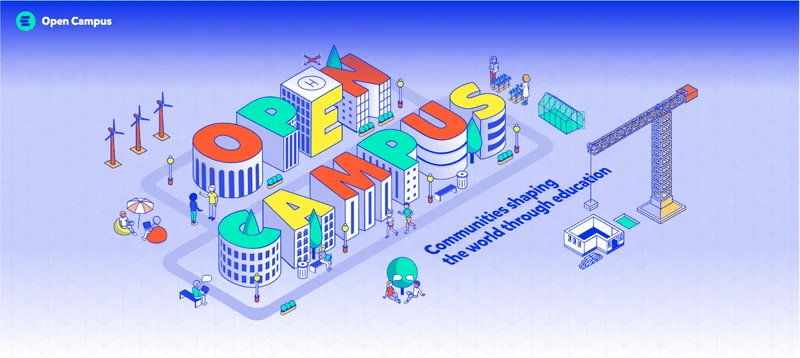Open Campus's $5M Funding Round: Analyzing the Raise and Its Web3 Education Model
Beyond the Buzzwords: A Sober Look at Open Campus's $5 Million Raise
Another funding announcement crosses the wire. The numbers flash: Open Campus, a Web3 education platform, has secured $5 million in a strategic round. The investor list is solid—Animoca Brands, YZi Labs, HongShan. The mission statement is suitably grand: to disrupt the $5 trillion global education industry. On the surface, it’s a standard-issue press release, precision-engineered to generate positive sentiment and a healthy bump for its native $EDU token.
But when you peel back the layers of marketing copy, the numbers tell a more nuanced, and frankly, more interesting story. Five million dollars is not an insignificant sum, but set against a $5 trillion target market, it’s a rounding error. It’s not the kind of capital you raise to boil the ocean. This isn’t a war chest for a global takeover of education. It’s a surgical injection of capital with a very specific purpose. The question isn't whether $5 million is enough to change the world of education. The real question is: what is this money actually for?
The stated goals are clear and logical. The funds are earmarked for building out core infrastructure: on-chain student loans through a partner, Pencil Finance; a verified digital identity system called Open Campus ID; a native OC Wallet; and the deployment of the EDU Chain mainnet. These are the pipes and plumbing of a decentralized ecosystem. They address legitimate, persistent problems like the ballooning $3 trillion—to be more precise, $3.7 trillion—global student loan market and the rampant issue of credential fraud.
This is all commendable. Building infrastructure is the unglamorous, essential work required for any protocol to achieve long-term viability. But it’s also a slow, methodical grind. It doesn’t produce the explosive user growth that typically excites venture capitalists. So why this amount, at this time? Is this simply about product development, or is there another variable in the equation?
The Quiet Part Out Loud: Market Price Support
Buried within the project team’s statements is the most revealing detail of the entire announcement. The $5 million raise will, among other things, "strengthen its EDU market price support." I've analyzed hundreds of funding announcements, and the explicit mention of using equity-raised capital for token market support is an outlier. It’s a refreshingly honest, if slightly jarring, admission of the dual reality all Web3 projects inhabit. They are simultaneously building a product for users and managing a liquid, tradable asset for speculators and believers.

This single phrase reframes the entire narrative. The funding isn't just for building educational tools; it's for ensuring the economic vehicle carrying the whole experiment—the $EDU token—remains stable enough to reach its destination. It’s like building a high-speed rail line across the country while also making sure you have enough cash on hand to keep the train's engine from sputtering out halfway through construction. The investors (Animoca's involvement, in particular, signals a deep understanding of tokenomics) aren't just betting on a new model for education. They are underwriting the stability of the token that underpins the entire ecosystem.
This creates an inherent tension. The goals of building a transparent, equitable education system are noble. But the need to support a token price introduces a set of market-driven pressures that can sometimes run counter to long-term product strategy. A stable token is crucial for incentivizing educators to create content and for the system’s loan mechanics to function properly. A collapse in value would shatter confidence and starve the ecosystem of participants. Yet, actions taken to support a price in the short term don't always align with the patient, user-focused development needed to build a lasting product.
Can a protocol truly serve two masters: the educational user who wants accessible learning and the token holder who wants a positive return? How does the Open Campus team plan to balance these often-competing interests, especially when market volatility inevitably strikes?
The decision to be transparent about this is the most compelling part of the story. It acknowledges that in Web3, the product and the market are inextricably linked. You can't build one without carefully managing the other. This $5 million isn't a moonshot; it's life support and a foundation pour, all in one. It’s capital to keep the lights on and the token stable while the real work of building the EDU Chain and its associated products gets done. It’s a bet that if they can just finish the infrastructure, the utility will eventually drive sustainable value, making overt "price support" a thing of the past.
A Calculated Bet on Infrastructure
Ultimately, my analysis suggests this $5 million raise should be viewed not as an offensive blitz on the education market, but as a calculated, defensive maneuver to secure the project's foundation. It’s a pragmatic admission that building a decentralized future is a capital-intensive marathon, not a sprint. The funds provide runway for the development team to finish the core plumbing—the chain, the wallet, the ID system—while simultaneously providing a backstop for the token economy that fuels it. It’s a bet on infrastructure over hype, a sober recognition that you can't build a new world on an unstable currency. The success of Open Campus won't be measured by this funding round, but by whether the utility they build with it can one day stand on its own, without the need for external support.
